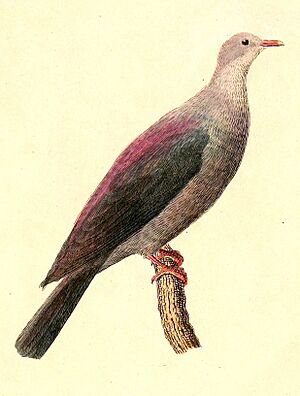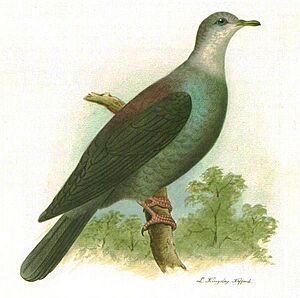Bonin wood pigeon facts for kids
Quick facts for kids Bonin wood pigeon |
|
|---|---|
 |
|
| 1832 illustration by Heinrich von Kittlitz | |
| Conservation status | |
| Scientific classification | |
| Genus: |
Columba
|
| Species: |
versicolor
|
The Bonin wood pigeon (Columba versicolor) was a type of pigeon. It lived only on the islands of Nakodo-jima and Chichi-jima. These islands are part of the Ogasawara Islands, located south of Japan.
Scientists know about this pigeon from only four specimens. The first one was found in 1827. The very last one was recorded in 1889. These pigeons were about 45 cm long. The Bonin wood pigeon became extinct in the late 1800s. This happened because of deforestation, hunting, and new animals like rats and cats.
Contents
What Did the Bonin Wood Pigeon Look Like?
The Bonin wood pigeon was a medium-sized bird. It grew to be about 45 cm long. Its upper body was mostly greyish-black. It had a special shiny, changing color called iridescence. This shimmer was seen on its crown, back, and shoulders.
The crown of its head had a green-purple shimmer. Its back and rump showed colors like violet, amethyst, and turquoise. Its shoulder feathers and parts of its back looked golden green with bronze hints. The wing feathers had a dark turquoise green color.
The tips of its upper tail feathers were golden green. Its chest and belly had deep green and violet shimmers. These colors were brightest on its chest. The pigeon's eyes were blue, or perhaps dark blue. Its bill was greenish-yellow with a pale tip. Its legs and feet were dark red.
When Was the Last One Seen?
The very last Bonin wood pigeon was found on September 15, 1889. It was collected in the forests of Nakodo-Jima, Japan.
How Did They Reproduce?
Bonin wood pigeons usually mated in trees or in the forest. They typically laid two eggs at a time. The eggs were quite vulnerable to crows and other animals that might eat them. It took about 17 to 19 days for the eggs to hatch. This is similar to how long it takes for other wood pigeons' eggs to hatch.
Why Did the Bonin Wood Pigeon Disappear?
The Bonin wood pigeon became extinct for several reasons. One major cause was deforestation. This means that many trees in their forest homes were cut down. This left them with fewer places to live and find food.
People also hunted these pigeons. This reduced their numbers even more. Another big problem was the arrival of new animals. Rats and cats were brought to the islands. These animals hunted the pigeons and their eggs. The pigeons were not used to these new predators. All these factors together led to the sad disappearance of the Bonin wood pigeon.



